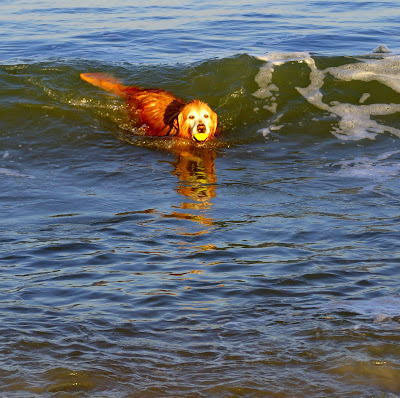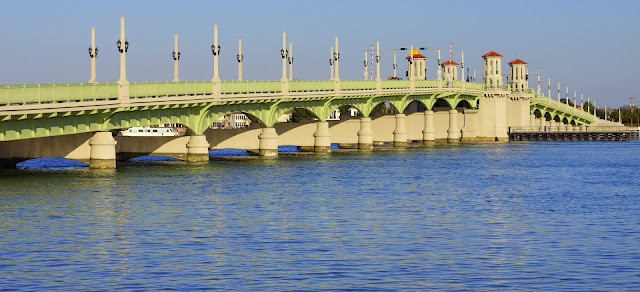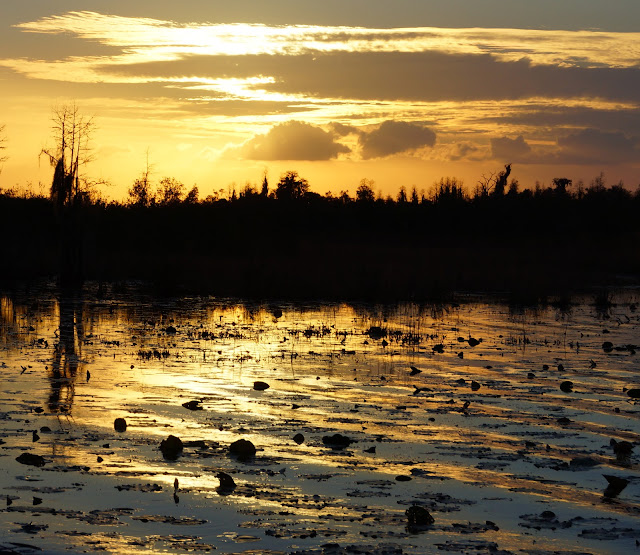As soon as we arrived at the viewing porch, there they were - a male and maybe two females. They only stayed around for a minute or so at the bird feeder. We just got really lucky.
Merritt Island also seems to be home to a plethora of these white butterflies, called a Great Southern White. We haven't seen them anywhere else, though their range is throughout the southern US coastal areas.
We got lucky a couple of times today. We walked along the boardwalk through the trees and happened upon this little guy (not that squirrels are uncommon).
You know how in National Parks, or wildlife refuges, every time you approach a body of water, or a meadow where the most desired animal of the park is supposed to be, you say to yourself, "Wouldn't it be cool if the wolves/grizzly/moose/painted bunting/alligator was right there when we walked up?" And so often they aren't. Well that little voice was going in my head, as usual, as we walked along the boardwalk toward one of the freshwater ponds. "Wouldn't it be cool if......
Yowza! Right under our feet! I've never been so close to one, or seen one swimming in such clear water. At least a ten footer, just drifting by, gently swishing his tail, with a couple of little fish following him around. We watched until he was on the other side of the pond. Not at all shy like most alligators who usually submerge at the sound of humans (more about that later).
I said to Rick, "Now I just have to see a manatee, and I'll be completely satisfied with my Florida wildlife experience." But I thought the chances of that were slim because the water temperature is still a little cool. Before we left the park we drove out to Haulover Canal, where the ranger told us we might see manatee. I've looked for manatee in Florida waters before and have always been disappointed. A vague shadow here and maybe a pair of nostrils there, in the fading twilight. But, as I said, we got lucky. There are at least three in this picture.
One had a GPS tracker tied to his or her tail. Boy did he get around! Even better unadvertised viewing was across the road where we went to check out the boat ramp for kayaking on the same canal. There must have been about ten manatee, very close to us and very active, but the water was much more cloudy. We watched them swim around for a long time, seeing lots of faces and tails and backs rising and falling. The experience slowed us way down, and left us feeling nicely peaceful, kind of like the feeling when you snorkel or scuba. We were so mellow we didn't want to disturb the experience by getting out our cameras. Taking pictures sometimes pulls you into an experience, but it can also push you out to the position of an observer, and I felt too much a part of this to separate myself that way.
On our way home, right before crossing the Indian River causeway over to Titusville, we pulled off to watch four kite surfers. It was intensely windy, so I guess it was a perfect day for theses guys.

A couple of them were catching some serious air.
Later that same day we went back out the same way past Merritt Island and over to the Canaveral National Seashore to spend some time on the beach. It was hot and sunny enough, and the water temperature was lovely, but it was still very windy, so the waves were huge, and pretty impossible for swimming. We took a nice walk along the beach and dabbled in the waves, and could feel how powerfully they pulled, even at ankle depth.
Home again, for some supper, and just before six we were visited in our backyard by the family of four deer that come every night.
Unfortunately our neighbors feed them, so they have become habituated. Feeding animals is something we see a lot of everywhere, and we also see a lot of warning signs about the dangers of feeding animals, especially the alligators. What is it that compels people to do this? Do they think they are being nice? Do they "love" animals so much that they must feed them even though it endangers them? Is it a sense of power - commanding the animals to come to them? I think it's a less-than-conscious compulsion that people are not examining in themselves. I realize that much of the wildlife that we see are examples of habituated animals, and though I feel fortunate to see them, I know we are not seeing natural behavior, and the animals we see may be endangering themselves or humans. We probably wouldn't have seen the painted buntings either if they weren't at the Visitors' Center bird feeder. I definitely have conflicted feelings about human and wildlife relationships (but I don't even own a bird feeder anymore, by choice, not just because we live in an RV).
OK, off the soapbox...
Believe it or not, our outings were not done for the day. After a filling supper of homemade ham, egg and cheese biscuits we went out to view a launch from the Kennedy Space Center, scheduled for 8:48 pm. We were prepared with cameras, ear plugs (recommended by a friend who found the space shuttle launch really loud, even at a distance) and layers. It was still very windy, with a chance of storms. We parked at the foot of the same causeway we'd been over four times already in one day, and walked out onto its rise to get a clear view of the whole Kennedy Space Center and the launch. At exactly 8:48 the launch site began to glow, and a ball of light silently lifted off the ground and rose smoothly into the sky. After about a minute it was gone. That was it. Kind of anticlimactic - like watching fireworks in the backyard as compared to a professional display. Locals tell us that the space shuttle was a whole different experience - this was just a satellite. Oh well. So, now we've seen a launch though it wasn't what we expected.
Good thing we had those earplugs, Don. ; )
























































